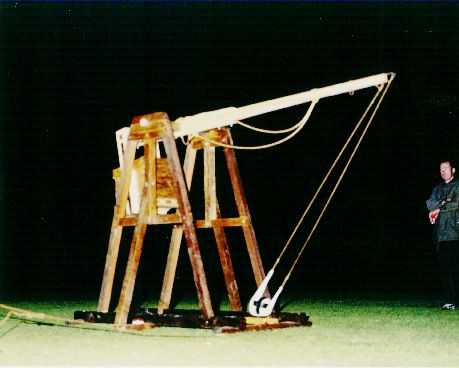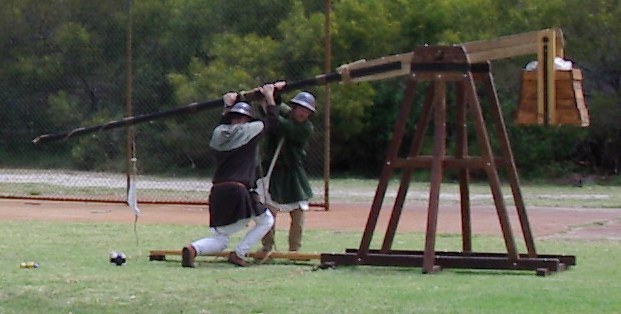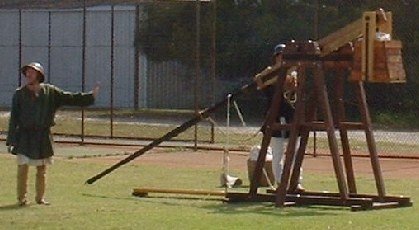
|
The Treb Files
Part 6:
|

|
The Treb Files
Part 6:
|
|
|
| Name: | Frankentreb |
| AKA: | "Scraps" |
| Class: | Hinged Counterweight Trebuchet |
| Size: | Throwing arm 2.35m, weight arm 0.60m, axle 2.10m high |
| Power Unit: | 100 kg - 150 kg of scrap iron and bags of sand in a heavy iron-strapped wooden bucket. |
| Projectiles: | 1kg & 2kg iron balls, 1.25 litre PET softdrink bottles and 1kg cloth trouserballs. |
| Range: | approx 100 metres with 1kg iron projectiles & earth-filled bucket, 70m with 1 kg trouserballs. |
| Based upon: | The frame was also inspired by a Traction treb illustration (Bibliotheque Nationale, Paris ), made for ease of disassembly and as a companion to Magog using available material. |
| Status: | in active use and evolving. |
|
Frankentreb is a trebuchet reborn. Made from the
long-stored remains of Gog (and quite a lot of reclaimed timber from
salvage yards), Frankentreb was intended to become a companion
trebuchet for Magog, similar in size and range. (As it turned out,
Frankentreb is about 10% bigger than Magog, but it's close enough) This gives us a pair of siege engines that can fire at the same target at displays. |
 |
|
Frankentreb
got its first hurling session at the Past Times Celebration in October
2000. Completed only the day before and never used, it needed to be
taken through its unpredictable tuning throws at the venue. Here Frankentreb is seen doing one of these throws at night. (Not long after this photo was taken the long sling was shortened to correct a tendency to throw low.) |
|
Technical Note: Have a look at the counterweight box in this photo. See how it is not hanging vertically, but is actually leaning with its top pointing out. This is due to a combination of two things: - the beam insists on swinging itself (and the axle that the bucket hangs from) through an arc of a circle centred on the main axle. Since the beam starts higher than horizontal, the first part of the fall will see the beam end swing outwards, hauling the top of the weight box with it. - but... the mass of scrap iron and sand in the box is trying to drop straight down. That mass is going to have to move sideways at some time in its fall, but right now it's easier for the box/bucket to just tilt... |

|
|
|
Displaying
a fine sense of aesthetics John perches up on the axle bearing blocks
and applies oil on the throwing arm to tone down the glaringly white
pine that had offended his taste (and also to provide some very useful
protection from the elements for the wood).
(John is also displaying a fine pair of 13th Century underwear - braes and hose. Not all re-enactment is glamorous...) |
|
|
|
|
Shock Horror: (The Tale of Frankentreb's Accident) Frankentreb's tuning continued into the night... the consistency of the release was fine, but the trebuchet was sending its projectiles off low and short. To correct this we needed to have the sling releasing at an earlier part of its swing around the beam end - which can be achieved in two ways: 1) bend the strong forged iron release prong back so that the hook is more open (hard work and there's always a slight risk of breaking something - not convenient on the morning of a performance) 2) shorten the sling cords to bring the sling into its release position earlier in the beam's travel, even if this sacrifices some of the trebuchet's power and efficiency (not a satisfying solution, but simple and reversable) Predictably, we went for the sling cord option but I wanted to get back to the long sling later, so I tied the cords at their new, shorter length and then knotted the excess cord back along the length of the rope still in use. This left loops in the ends of the sling cords, but we didn't think anything of it at the time as we headed up to the hall for eats, coffee and a little "busy bee" to make even more trouserballs...
Next morning we wandered back to our sports oval firing range to
complete the ranging-in and to build the target wall from cardboard
boxes. After the previous night's adjustment Frankentreb was loosing
the trouserballs down range beautifully. The treb looked good and the
balls kept landing in the same patch. Happy, we set to adjusting Magog
to land its trouserballs in the same place, and managed in about half a
dozen shots... brilliant. The sling had fouled the trigger and had tried to bring the beam to a dead stop with the bucket already plummeting down. It wasn't going to happen and the throwing arm timber snapped like a twig. With the projectile and throwing arm gone (the torn-off timber hanging loose on its safety rope) the suddenly unloaded trebuchet did the world's worst dry fire and thrashed its weight box around. Sand bags ejected their contents, spraying sand out spectacularly from the top of the box and even from between its planking. Miraculously, the box and trebuchet survived - but there would be no more firing for Frankentreb that weekend. The beam's throwing arm was beyond help. |

|
|
|
Epilogue: The show must go on, and Magog did the performance alone. The wall of boxes (with Steggle the dummy on top) was eventually hit and knocked down, a satisfying result even if we didn't get the spectacle of two trebs working side-by-side. Frankentreb was carted home for a thorough check and to have the throwing arm section of his 3-part beam replaced. This photo shows poor, broken Frankentreb standing behind the other trebuchets - the snapped off stump of its beam pointing straight up. |
|
|
|
| "Target Shooting"
A few months after Past Times III the repaired Frankentreb was given a test shoot at a friend's farm to trial its new beam. The target was set up at about 100 metres range. The shots, using the our standard "target shooting" projectiles of 1kg iron balls, had to pass over and between a number of trees to reach the improvised target - a forklift pallet and a number of wooden planks stacked up in front of it. The camera was set up off to the side of the trebuchet and behind the firing line. The view of the target was also filmed from there, with strong zoom. This clip shows a shot where the ball strikes and passes through the timber target. (n.b. Video capture on this clip is poor - a new version will be made available ASAP. ) (Video size: 176k ) |
|
|
| "Expansion Pack"
For Past Time IV Frankentreb got a temporary theatrical make-over... the 4 metre throwing arm from Quasimodo (the retired traction trebuchet) was fitted to a new beam end section and became Frankentreb's "extended version" beam. This gave the beast an overall height of over 6 metres. |

|
|

|
|
| Performance was sacrificed to achieve this extended beam as we hadn't the time to raise the height of the main axle by building new or extended side frames. This meant that the beam could only be hauled down to a shallow angle before its tip was near the ground, and this in turn meant that the drop height for the bucket was reduced. | |
| The larger, heavier beam
had an additional effect on the machine - its momentum resulted in a
later beam "stall" (the beam getting well past vertical before pausing)
and this, in turn, gave it a later release of the sling. Consequently,
Frankentreb was launching projectiles with a flatter-than-intended
trajectory. However, even with this situation, the machine put on a good show and was able to power 1.25 litre plastic softdrink bottles into a hockey/soccer training goal time after time. |
| Last Edited: June 2004 |
|
Russell Miners |